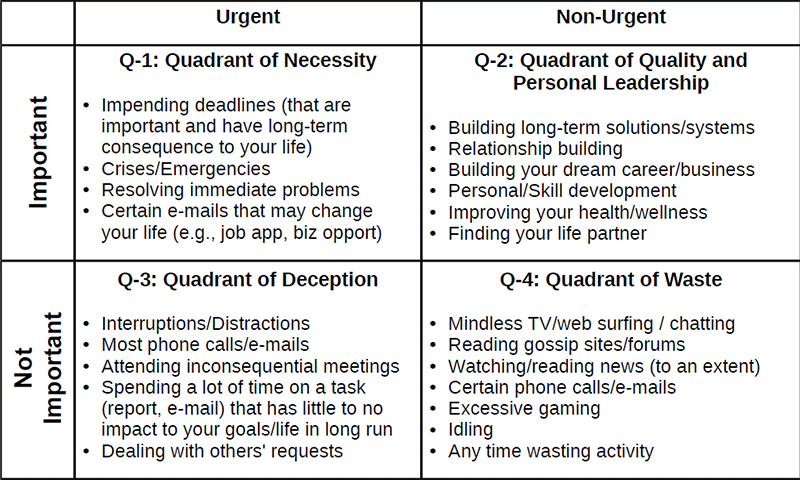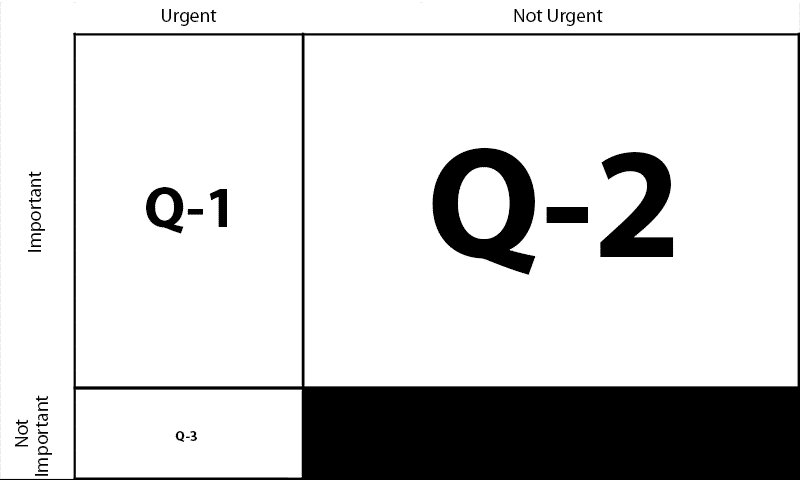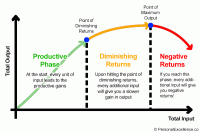
(Image: james)
Put First Things First is Habit # 3 of Stephen Covey’s book The 7 Habits of Highly Effective People.
Do you put your first things first? Putting first things first means doing the most important things in life. It means being clear about your priorities and acting on them.
That sounds pretty easy and intuitive, but many people fall into the trap of getting caught up in non-important things. They neglect the larger life priorities until it becomes too late to act on them. To become a master of your time, you need to first be aware of your priorities in the larger context of your life. The framework that I will be sharing with you in this article — the Time Management Matrix — is tremendously useful in helping you achieve that. It will help you structure your daily activities and deal with them based on priority.
The Time Management Matrix is the fourth generation in a series of time management systems developed to give us more control of our lives. Each system builds on the one before it to help us gain greater control of our time.
First Generation: Reminders
The first generation of systems is about “reminders” — reminding ourselves of our tasks using notes and to-do lists. While these are generally helpful, there are two downsides.
- Firstly, commitments may not be kept, because people do tasks as they appear as on the list or according to what may seem important at the time.
- Secondly, there is a lack of long-term vision. Using lists do not enable us to look ahead or get to the truly important tasks.
Second Generation: Planning and Preparation
The second generation improves on that. It is about “planning and preparation” — looking ahead, identifying deadlines, and scheduling future events accordingly. Tools used include calendars and appointment books. With this system, we now have personal accountability since our tasks are tied to a certain deadline. We can be more organized and prepared, such as for meetings and appointments.
However, the downside is we become fixated on what is on the calendar. In our focus to complete our tasks, we may tune out “distractions,” such as a call from friends or family time, even though we may genuinely value people and relationships!
Third Generation: Prioritizing, Planning, and Controlling
The third generation addresses that somewhat. It is about “prioritizing, planning, and controlling” which includes clarifying values and goal setting based on those values. Daily tasks are subsequently planned in accordance with these goals. Tools used include the personal organizer and electronic or paper-based planners.
Most of us use this system today. When I was studying at business school, most people used this system. Everyone’s common goal was to have a successful career in a reputable company; subsequently, our daily tasks revolved around getting good grades, project work, and studying.
However, the system does not factor in deeper values like relationships, spirituality, and inner peace which are more important in the bigger picture. While people become highly successful in goal achievement with the third generation system, they eventually reach a point where there is a conflict between their goals and what gives them deeper meaning in life. An example would be overachieving corporate professionals who feel a sense of emptiness despite a successful career.
Fourth Generation: Quality and Personal Leadership
The fourth generation system addresses this gap. It helps us focus on identifying higher-value tasks and accomplishing results. This is done by using the Time Management Matrix to first classify our daily activities by Urgency/Importance, and then to deal with them based on the Quadrant they fall in.
Time Management Matrix: The 4 Quadrants
The Time Management Matrix is also known as the Eisenhower Matrix. It was created by Dwight D. Eisenhower, the 34th president of the United States, and was later popularized by Stephen Covey in his book, The 7 Habits of Highly Effective People.
Using The Time Management Matrix, our daily activities can be broken down into 4 Quadrants, sorted by urgency and importance:

4 Quadrants of the Time Management Matrix along with examples (Image: Personal Excellence)
Quadrant 1: Quadrant of Necessity
You will find your crises or emergencies here. Quadrant 1 screams for our attention because of its urgent and consequential nature.
However, many people fall into the trap of getting caught up in Q1. By spending all our time here, we become consumed with firefighting every day instead of crisis prevention. Side effects include stress, burnout, constant firefighting, and resolving problems instead of preventing them in the first place. We often see working level employees, advertising executives, accountants, etc. getting consumed by this quadrant.
Quadrant 3: Quadrant of Deception
Some people spend a lot of time dealing with Q3 tasks and confusing them with Q1 tasks. They think the tasks are important when they are not. For example, you may be spending a lot of time on a certain report that does not have any effect on your overall job performance or appraisal. Or you constantly attend meetings that have no value-add. This is why Q3 is called the Quadrant of Deception. Many times, the urgency of these tasks are due to others’ priorities or needs.
A good way to differentiate a Q3 task from a Q1 task is to ask yourself: “Is this task related to my goals? Does doing this make any difference to me?” Focusing on Q3 results in short-term focus, being out of control of your life, and not being able to stick with your goals and plans.
Quadrant 4: Quadrant of Waste
This is called the Quadrant of Waste, and for good reason — it contains all your time wasters. People living unconsciously have a tendency to hover around Quadrants 3 and 4. After resolving their Q3 tasks, they enter auto-pilot mode and spend all their time in Q4. This can be because they have nothing better to do or they are procrastinating on the things they should be doing. Quadrant 4 creates no value in our lives whatsoever. Focusing on Q4 results in irresponsible behavior and dependency on other people.
Quadrant 2: Quadrant of Quality and Personal Leadership
Q2 is the magic quadrant we need to focus on. It is the most important quadrant, yet the most often neglected one.
Q2 is about having personal leadership and focusing on the important tasks that matter. Q2 tasks reflect your life goals and desires, which are linked to your life purpose. To correctly define them, you need to be clear on your life purpose first— so if you have not discovered your life purpose, please read my 7-part series on How To Find Your Life Purpose!
There are two reasons why Q2 tasks are often neglected: Firstly, Q2 tasks never become urgent until it is too late. For example, taking care of your health or pursuing your dreams. Secondly, compared to other quadrants, these tasks require more investment of energy and time to see results, which conflicts with modern society’s obsession with instant results.
However, Q2 tasks reap the most reward in the long run. Think about it as sowing seeds for future harvest.
- Imagine you are a lawyer whose dream job is to be a literature teacher (Q2 task). While working as a lawyer, you start studying for a degree in literature. You also take up teaching courses. While these will take a few years until completion, you have planted the seed. You know it is a matter of time before you will enjoy the harvest — being a full-fledged teacher.
- Another example would be relationships. Maybe you desire to get into a rewarding, long-term relationship (a Q2 task). Acting on this Q2 goal means starting the conscious search for a relationship partner. Even though it may take you a while before you find someone you like, you will experience benefits earlier than if you procrastinate on this.
After you plant your seeds, you will need to continuously water and care for them. However, it is a matter of time before you can reap the rewards of your labor. On the other hand, if you keep on putting off these Q2 tasks, everything will remain the same, whether it’s 5, 10, or 20 years from now. Focusing on your Q2 will create vision, perspective, balance, and control.
Think about all the things you do on a typical day. Now, classify them into their respective quadrants. How much time and effort do you spend on each quadrant? Are there any tasks in your Quadrant 2 that you are neglecting? Strengthening your relationship with your family perhaps? Finding your life partner? Improving your health? Or investing in personal development?
To be effective, you need to consciously alter your behavior in the following ways:
- Q-1 Tasks: Manage immediately to get them out of the way. Spend the required effort such that they do not blow out of portion.
- Q-2 Tasks: Focus disproportionately due to the high payoff from the investment.
- Q-3 Tasks: Delegate to other people due to their urgent nature, but be minimally involved as they are not important.
- Q-4 Tasks: Dump them as they are neither important nor urgent.
The table below illustrates a breakdown of how effective people allocate their time. The bigger the quadrant size, the more time you should spend on it:

An ideal allocation of time across the 4 quadrants, with 0% of time going into Q4 (Image: Personal Excellence)
Notice that Q2 should take up the bulk of your time, followed by Q1. Q3 takes up a minimal proportion. Q4 tasks are completely out of the picture.
Applying Time Management Matrix in my life
If you are living in an unconscious manner, you will find the majority of your time spent in Quadrants 1, 3, and 4. When I first learned about the Time Management Matrix, I was surprised to know that many of my Q2 tasks were neglected. Most of my time was spent in Q1, followed by Q3, and finally Q4.
For example at work, I would spend the majority of my time firefighting and dealing with crises. This was especially so as I was a project manager where meeting timelines was crucial. I was also unconsciously investing my time in Q3 tasks and thinking that I was being productive, such as writing unnecessary reports, attending unimportant meetings, and dealing with others’ requests.
After I was done with the Q1 and Q3 tasks, I would be too tired to do any brain work. I would move to mindless activities, which were the Q4 tasks. These included random web surfing, rewatching drama series, shopping, and playing games. On the other hand, I had Q2 goals like eating healthier, exercising, pursuing my passion, and improving my relationship with my family. While I recognized them as important, they were always last on my to-do list as because they never struck me as urgent. If I ever planned a Q2 task, I would almost never get to it as the Q1 and Q3 tasks would always take center stage. Q2 tasks were always left for tomorrow or next time since they were not urgent.
A year later, I reviewed the framework. Guess what I found? There was almost no change in how I spent my time across the 4 quadrants! Despite wanting to work on my Q2 goals, they kept moving to the back burner because there were always new, urgent things emerging every day, taking up my time and attention. Despite being incredibly efficient in my Q1 and Q3 tasks, my life was not very different vs. a year ago.
By constantly working on the urgent, I did not have any time for my Q2 goals — the most important areas of my life. It became clear that unless I consciously prioritize my Q2 tasks/goals, nothing is ever going to happen to them.
Understanding that was very powerful for me. From then on, I became more proactive in working on my Q2 goals. First, I wrote my Q2 goals in a document. Then, I developed strategies and plans to achieve these goals. Every time I started an activity, I would evaluate to see which quadrant it belonged to. Depending on the quadrant, I would either do it myself (if it was a Q1 task), spend disproportionate time/effort on it (Q2), delegate it (Q3), or dump it (Q4).
It was not easy. When I first started this, there were many times when I would slip into my previous response model. But as time passed, I started seeing the benefits of investing in Q2 tasks. For example, after I started working on eating healthier and exercising more often, I began to lose excess weight. After I started my business, I became much more fulfilled. After I worked on finding love, I attracted my soulmate (who is now my husband) into my life.
Today, I naturally work on my Q2 tasks. That’s because Q2 is a “gold mine” — when you take the time to “mine” it every day, you will see rewards after a while. As for the Q1, Q3 and Q4 tasks, my goal is to get them out of the way so that I can get back to focusing on Q2, because I know working on Q2 will give me the biggest rewards in the long run. :D
Apply the Matrix to your life
Try adopting the Time Management Matrix for a few months and see how it works for you. :) The next time you do something, evaluate which quadrant it falls under. Is it Q1, Q2, Q3, or Q4? Are you adopting the right action for such a task? What are the Q2 tasks you are neglecting in your life? Start working on them today and in time to come, you will be reaping the fruits of your labor.






![The Emotional Journey of Creating Anything Great [Infographic]](https://personalexcellence.co/files/infographic-emotional-journey-of-creating-anything-great-200x110.png)


 Thanks for reading. If you like my free articles, join my private email list and get my latest updates and articles sent right to your inbox.
Thanks for reading. If you like my free articles, join my private email list and get my latest updates and articles sent right to your inbox.